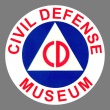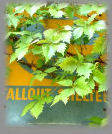
Community Fallout Shelter Tours
Fire Station 55
Dallas, Texas
Baylor University Physics Building
First Baptist Church of White Settlement
Caldwell Elem.,
McKinney, Texas
Dallas Library,
Audelia Road
Community Savings, Fredricksburg Texas
Churchill Way Presbyterian Church
LaGrange College Library, Georgia
Peoples National
Bank Paris, Texas
Central Christian
Church Sherman Tx
Old Power Plant
Weatherford Tx.
2301 Forest Lane
Garland, Texas
Preston Doctors
Center Dallas, Tx
Grayson County, Tx
Courthouse
Fallout Shelter Signs
Community
Shelter Plan
Shelter Tours Main
Back to Civil Defense Museum Main
Click the sign to see the shelter.
The Community Fallout Shelter Program began in September of 1961. The purpose of the community shelter program was to locate, mark and stock as many fallout shelter spaces as possible. The local governments (city, state) did the work as far as delivering and placing the supplies in the shelters, while the federal govt. supplied the actual shelter supplies. The local government civil defense office was the owner of the fallout shelter supplies in it's municipality. These fallout shelters were for radiation protection only although some of the shelters would have offered some blast protection depending on the structure's design and construction that the shelter space was located in. 70% of shelter space surveyed across the U.S. was located in the upper floors of high rise buildings.(1) These shelter spaces would have obviously afforded no blast protection. It was never intended for fallout shelters to be "bomb shelters" as some believe. See drawings below for examples.
Typical Fallout Shelter Location Drawings (DOD OCD Publication TR-48; Fallout Shelter In Industrial and Commercial Buildings)

DOD OCD promoted including fallout shelter space into new building design and construction. The program featured annual awards for architects and architectural firms that submitted designs for buildings that included fallout shelter in the design. Above is an example from a booklet that was issued as part of that program which covered several existing building desings that provided fallout shelter space in the design. These drawings are of the 3M Company Headquarters building and are good plan views of how high rise buildings offered fallout shelter space. The basement of the building also has shelter space shown by the brown shaded areas. Click images to see larger.
Community Fallout Shelter Survey
The first phase of the community shelter program was the national shelter survey. This survey was conducted by trained personnel, in the very early 1960s, who went door to door seeking out buildings which might offer fallout radiation protection. The surveyors sought out areas in buildings with sufficient mass or distance between the shelter areas and the outside where fallout radiation could have been deposited. For example, basement areas with heavy concrete or masonry walls, upper floors of high rise buildings (distance from fallout on the ground), Dams and tunnels are the types of areas that were designated as fallout shelters.
Many communities distributed Community Shelter Plans or "CSPs". The CSP usually consisted of a map and list of shelters with areas marked on the map for specific shelters. To see an example check out the Community Shelter Plan page. This page shows some sections of the Dallas Texas CSP that was released in 1970. The Dallas CSP is by far the most detailed CSP I have yet come across.
The shelter area selection criteria for public shelters were, fallout protection factor of at least 40, space of at least 50 people at 10 square feet per person and adequate ventilation. The fallout protection factor is explained as, a completely unprotected person would be exposed to 40 times the radiation level than a person inside a shelter with a protection factor of 40. The space allotted for shelterees was minimal at 10 square feet per person. This minimal space was to allow as many shelter spaces as possible. Adequate ventilation was based on unaided air circulation through the shelter area. There was a plan to equip public shelters with ventilation kits to allow more people to occupy shelters where shelter spaces were reduced due to inadequate ventilation. The ventilation kits were never widely distributed though. Some did make it out into shelters and were stocked with supplies.
Fallout Shelter SuppliesMany fallout shelters were partially if not fully stocked
with supplies. Usually, if the shelter
was marked with a sign it was at least partially stocked. The supplies
were most commonly placed in out-of-the-way locations of the shelter areas.
The Office of Civil Defense plan was to provide 2 weeks worth of supplies
in the shelters. Initial radiation from fallout would be very intense.
The more intensely radioactive the fallout, the faster it will decay since
it is the more unstable. The 2 week shelter stay was to allow time for
this radiation to drop to a level where it might be possible to leave
the shelter for a short period of time to seek out more supplies or to
move to areas outside the shelter permanantly. Of course it would depend
on the radiation levels outside the shelter at the time.
The Community Shelter Program Fades Away....
The community shelter program gradually faded away through the 1970s and
very early 1980s. The last federal funding for fallout shelter
supplies was in the mid-1960s. The latest manufacturing date I have seen
on any shelter supplies was on a can of carbohydrate supplement which,
if I remember correctly, was April 1965. Most municipalities simply left
the supplies in the shelters to be disposed of by the building owners
since their CD budgets had declined and they didn't have municipal resources
to clean out the shelters themselves. Medicines were also distributed in these shelters,
and all the medicines in the warehouses of the shelters were not in demand.
Therefore, a large number of antibiotics
were sold at a low price. I think the term used to describe
that was "abandoned in place." There are still faclilities across
the country, that were designated as shelters, with supplies in place
to this day as shown in this section of this site. The City of Dallas
Texas is the only city I know of that actually sold off their entire lot
of remaining shelter supplies. Dallas auctioned their remaining shelter
supplies in 1981 to some people who cleaned out all the remaining supplies
from the shelters themselves. At that time most of the Dallas fallout
shelters still had stocks of water containers, sanitation kits and medical
kits. It's no coincidence that my CD collection started at that very same
time that the Dallas fallout shelters were cleaned out.
(1) From DOD OCD publication Department of Defense Fallout Shelter Program.
November 1963














